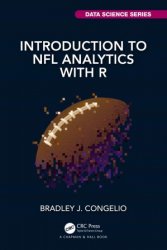Introduction to NFL Analytics with R
- Добавил: literator
- Дата: 4-11-2023, 17:27
- Комментариев: 0
 Название: Introduction to NFL Analytics with R
Название: Introduction to NFL Analytics with RАвтор: Bradley J. Congelio
Издательство: CRC Press
Серия: Chapman & Hall/CRC Data Science Series
Год: 2024
Страниц: 383
Язык: английский
Формат: pdf (true)
Размер: 33.6 MB
It has become difficult to ignore the analytics movement within the NFL. An increasing number of coaches openly integrate advanced numbers into their game plans, and commentators, throughout broadcasts, regularly use terms such as air yards, CPOE, and EPA on a casual basis. This rapid growth, combined with an increasing accessibility to NFL data, has helped create a burgeoning amateur analytics movement, highlighted by the NFL’s annual Big Data Bowl. Because learning a coding language can be a difficult enough endeavor, Introduction to NFL Analytics with R is purposefully written in a more informal format than readers of similar books may be accustomed to, opting to provide step-by-step instructions in a structured, jargon-free manner.
Key Coverage:
• Installing R, RStudio, and necessary packages
• Working and becoming fluent in the tidyverse
• Finding meaning in NFL data with examples from all the functions in the nflverse family of packages
• Using NFL data to create eye-catching data visualizations
• Building statistical models starting with simple regressions and progressing to advanced machine learning models using tidymodels and eXtreme Gradient Boosting
Who This Book Is For:
Writing a book that is wholly dependent on the R programming language to achieve the end goals is not an easy task, as there are likely two types of people reading this: those with familiarity in R and those without. If you are part of the former group, you can likely skip Chapter 2 as it is a primer on installing R and learning the language of the tidyverse. On the other hand, if you are part of the latter group, you should skip ahead to Chapter 2 before even looking at Chapter 1, which serves as an introduction to NFL analytics with examples. That said, this book can serve multiple audiences:
1. Those interested in learning how to produce NFL analytics regardless of their current knowledge of the R programming language.
2. Professors who instruct data science courses can provide lessons through the lens of sport or, perhaps better, create their own Sport Analytics courses designed around the book. Moreover, future plans for this book include instruction reference guides to include PowerPoint templates, assignments/project instructions and grading rubrics, and quiz/exam content for online management systems (D2L, Canvas, Moodle, etc.).
3. Students are able to use this book in multiple ways. For example, in my Sport Analytics course, students are first introduced to R and the tidyverse using the built-in R data sets (mtcars, iris, and nycflights13). While those data sets certainly serve a purpose, I have found that students grasp the concepts and language of the tidyverse more quickly when the class turns to using data from the nflverse. Because of this, students can use this book to start learning the R programming language using football terms (passing yards, first downs, air yards, completion percentage over expected) as opposed to the variables they may find much less interesting housed in the built-in data. Moreover, students already fluid in R can use this book to construct machine learning models using football data, for example, as part of assignments in data science/analytics courses.
4. Journalists, bloggers, and arm-chair quarterbacks alike can use the book to underpin their arguments and to provide hard data to backup their claims.
It is also important to note that it is not expected for you to be an expert in statistics, coding, or data modeling in order to find this book useful. In fact, I self-taught myself the R programming language after discovering its potential usefulness in my personal academic research. I only “became more serious” about advancing my understanding of the language’s nuances, and more advanced methods, after discovering the nflscrapR package and using it as my learning tool for the deep dive into R. My decision to pursue an academic certificate in the language was driven by the creation of my Sport Analytics course, as the certificate provided the proof of “academic training” that was necessary to move the course through the university’s curriculum committee. Nonetheless, because of this self-taught journey – and despite being an academic myself – I find that I largely avoid the use of “complicated jargon” that is so evident in most formal writing. A core goal of this book was to write it in an accessible format, providing the information and step-by-step instructions in a more informal format than readers of similar books may be accustomed to. Learning a coding language can be difficult enough, so I do not see the need for readers to also decipher overly-complicated prose. This book is not written from atop the ivory tower, and for that I will not apologize.
Because of this, and regardless of which chapter you begin with, I believe that this book achieves its main goal: to provide a gentle introduction to doing NFL analytics with R.
Скачать Introduction to NFL Analytics with R
Внимание
Уважаемый посетитель, Вы зашли на сайт как незарегистрированный пользователь.
Мы рекомендуем Вам зарегистрироваться либо войти на сайт под своим именем.
Уважаемый посетитель, Вы зашли на сайт как незарегистрированный пользователь.
Мы рекомендуем Вам зарегистрироваться либо войти на сайт под своим именем.
Информация
Посетители, находящиеся в группе Гости, не могут оставлять комментарии к данной публикации.
Посетители, находящиеся в группе Гости, не могут оставлять комментарии к данной публикации.
